Page 12 of 546
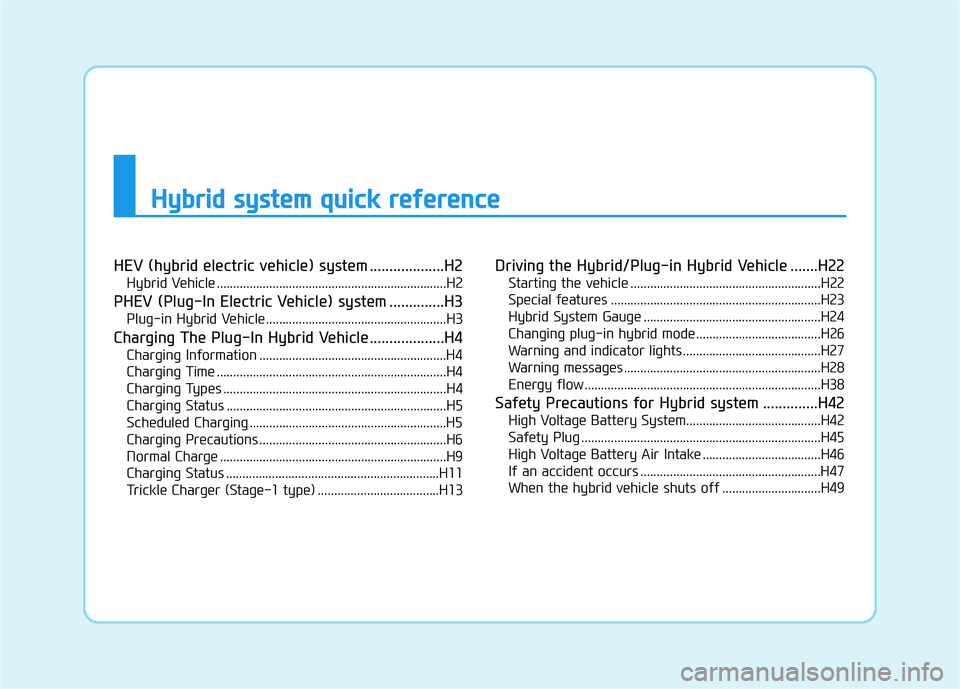
HHyybbrriidd ss yy ssttee mm qq uu iicc kk rr ee ffee rree nn ccee
HEV (hybrid electric vehicle) system ...................H2
Hybrid Vehicle ......................................................................H2
PHEV (Plug-In Electric Vehicle) system ..............H3 Plug-in Hybrid Vehicle.......................................................H3
Charging The Plug-In Hybrid Vehicle ...................H4 Charging Information .........................................................H4
Charging Time ......................................................................H4
Charging Types ....................................................................H4
Charging Status ...................................................................H5
Scheduled Charging ............................................................H5
Charging Precautions .........................................................H6
Normal Charge .....................................................................H9
Charging Status .................................................................H11
Trickle Charger (Stage-1 type) .....................................H13 Driving the Hybrid/Plug-in Hybrid Vehicle .......H22
Starting the vehicle ..........................................................H22
Special features ................................................................H23
Hybrid System Gauge ......................................................H24
Changing plug-in hybrid mode ......................................H26
Warning and indicator lights ..........................................H27
Warning messages ............................................................H28
Energy flow ........................................................................H38
Safety Precautions for Hybrid system ..............H42 High Voltage Battery System.........................................H42
Safety Plug .........................................................................H45
High Voltage Battery Air Intake ....................................H46
If an accident occurs .......................................................H47
When the hybrid vehicle shuts off ..............................H49
Page 13 of 546
H2
Hybrid Vehicle
HHEEVV (( HH YY BBRRIIDD EE LLEE CCTT RR IICC VV EEHH IICC LLEE )) SS YY SSTT EEMM
The HYUNDAI Hybrid Electric Vehicle (HEV) uses both the gasoline engine and the electric motor for power. The elec-
tric motor is run by a high-voltage HEV battery.
Depending on the driving conditions, the HEV computer selectively operates between the engine and the electric motor
or even both at the same time.
Fuel efficiency increases when the engine is off at idle, or when the vehicle is driven by the electric motor with the HEV
battery.
The HEV battery charge must be maintained, so at times the engine will come on even at idle to act as a generator.
Charging also occurs when decelerating or by regenerative braking.
OLFH054001
Startup/Low speed cruise
Electric motor
AccelerationElectric motor + Engine High speed cruiseEngineDecelerationCharging Stop Engine OFF
Page 14 of 546
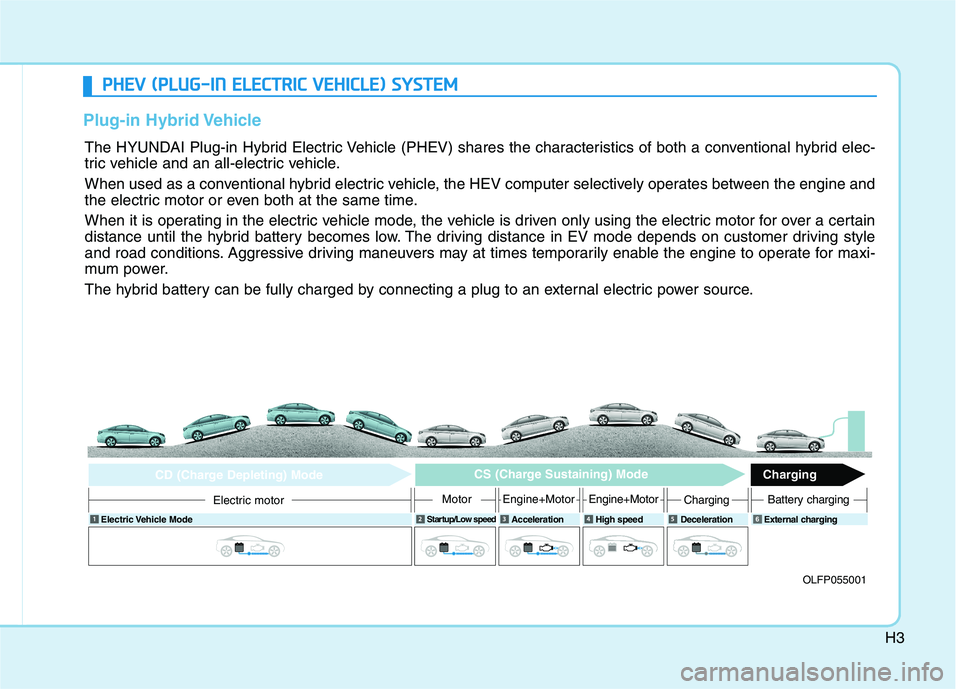
H3
PPHH EEVV (( PP LLUU GG--IINN EE LLEE CCTT RR IICC VV EEHH IICC LLEE )) SS YY SSTT EEMM
Plug-in Hybrid Vehicle
The HYUNDAI Plug-in Hybrid Electric Vehicle (PHEV) shares the characteristics of both a conventional hybrid elec-
tric vehicle and an all-electric vehicle.
When used as a conventional hybrid electric vehicle, the HEV computer selectively operates between the engine and
the electric motor or even both at the same time.
When it is operating in the electric vehicle mode, the vehicle is driven only using the electric motor for over a certain
distance until the hybrid battery becomes low. The driving distance in EV mode depends on customer driving style
and road conditions. Aggressive driving maneuvers may at times temporarily enable the engine to operate for maxi-
mum power.
The hybrid battery can be fully charged by connecting a plug to an external electric power source.
OLFP055001
Electric Vehicle Mode
Startup/Low speed
Acceleration High speed Deceleration External charging
Electric motor
CD (Charge Depleting) Mode CS (Charge Sustaining) Mode
Charging
MotorEngine+MotorEngine+MotorChargingBattery charging
6
Page 15 of 546
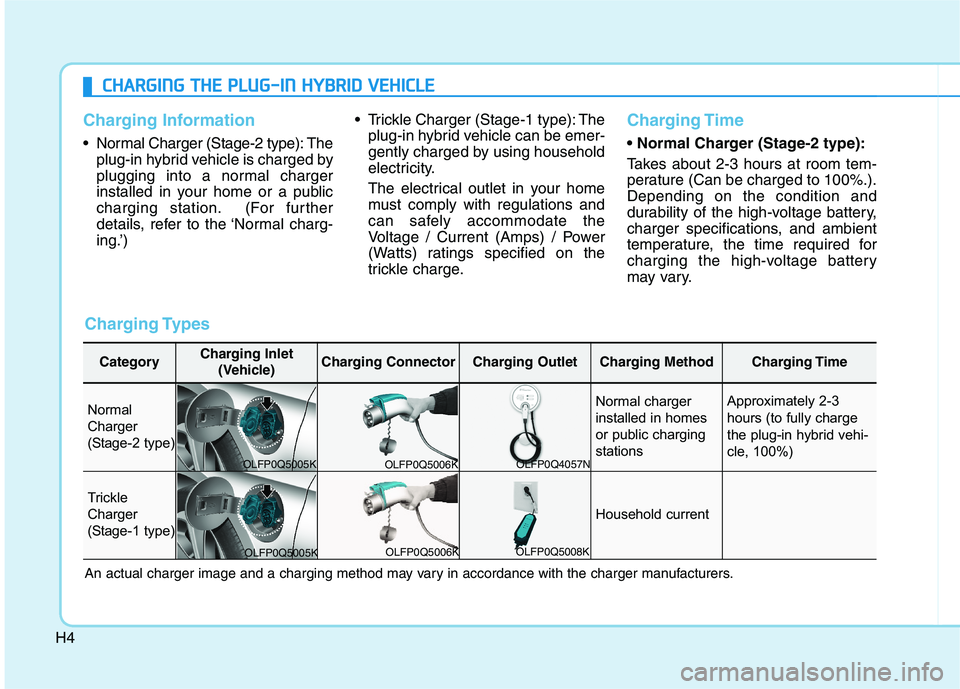
H4
CCHH AARRGG IINN GG TT HH EE PP LLUU GG--IINN HH YY BBRRIIDD VV EEHH IICC LLEE
Charging Information
• Normal Charger (Stage-2 type): The
plug-in hybrid vehicle is charged by
plugging into a normal charger
installed in your home or a public
charging station. (For further
details, refer to the ‘Normal charg-
ing.’) Trickle Charger (Stage-1 type): The
plug-in hybrid vehicle can be emer-
gently charged by using household
electricity.
The electrical outlet in your home
must comply with regulations and
can safely accommodate the
Voltage / Current (Amps) / Power
(Watts) ratings specified on the
trickle charge.
Charging Time
• Normal Charger (Stage-2 type):
Takes about 2-3 hours at room tem-
perature (Can be charged to 100%.).Depending on the condition and
durability of the high-voltage battery,
charger specifications, and ambient
temperature, the time required for
charging the high-voltage battery
may vary.
Charging Types
CategoryCharging Inlet
(Vehicle)Charging ConnectorCharging OutletCharging Method Charging Time
Normal
Charger
(Stage-2 type)Normal charger
installed in homes
or public charging
stations Approximately 2-3
hours (to fully charge
the plug-in hybrid vehi-
cle, 100%)
Trickle
Charger
(Stage-1 type)
Household current
An actual charger image and a charging method may vary in accordance with the charger manufacturers. OLFP0Q5005K
OLFP0Q5006K
OLFP0Q5006K OLFP0Q5008KOLFP0Q4057N
OLFP0Q5005K
Page 16 of 546
H5
Charging Status
You can monitor the charging status
outside of the vehicle when charging
the high-voltage battery.
Scheduled Charging (if equipped)
You can set-up a charging sched-ule for your vehicle through the
Blue Link AVN control unit.
Refer to the Multimedia manual or
the Blue Link manual for detailed
information about setting sched-uled charging.
Scheduled charging can only be done when using a normal charger
or the portable charging cable
(ICCB: In-Cable Control Box).
OLFPQ047737
Charging StatusIndicator
Charging in
progressIlluminates (green)
Fully chargedOff
Scheduled chargingBlinks (green) and then turns off
MalfunctionBlinks (red)
Page 19 of 546
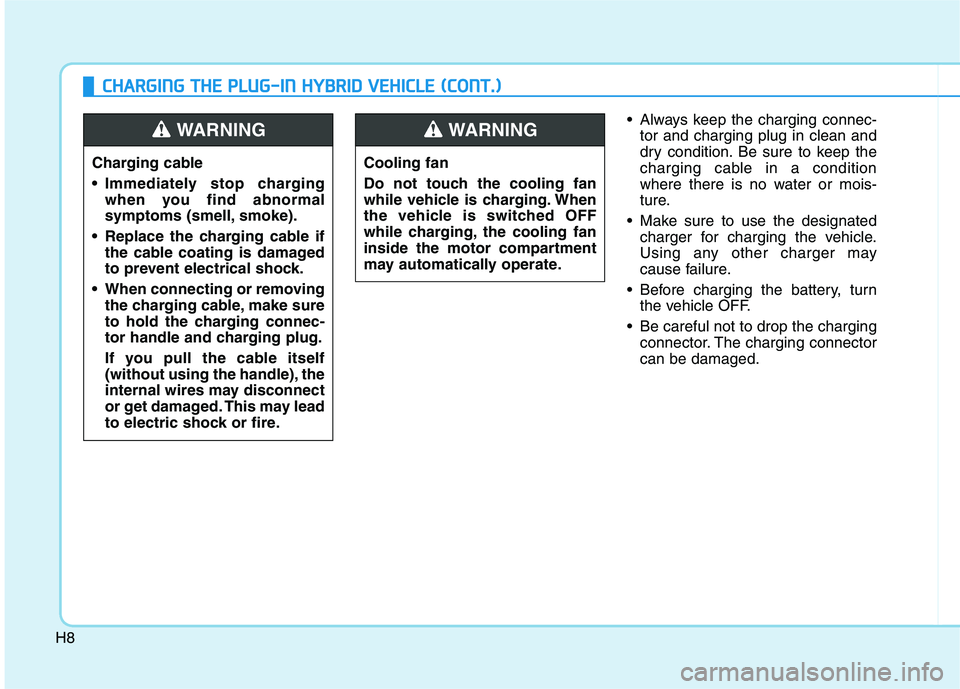
H8
CCHH AARRGG IINN GG TT HH EE PP LLUU GG--IINN HH YY BBRRIIDD VV EEHH IICC LLEE (( CC OO NNTT..))
Always keep the charging connec-
tor and charging plug in clean and
dry condition. Be sure to keep the
charging cable in a condition
where there is no water or mois-
ture.
Make sure to use the designated charger for charging the vehicle.
Using any other charger may
cause failure.
Before charging the battery, turn the vehicle OFF.
Be careful not to drop the charging connector. The charging connectorcan be damaged.
Cooling fan
Do not touch the cooling fan
while vehicle is charging. When
the vehicle is switched OFF
while charging, the cooling fan
inside the motor compartment
may automatically operate.WARNING
Charging cable
Immediately stop charging
when you find abnormal
symptoms (smell, smoke).
Replace the charging cable if the cable coating is damaged
to prevent electrical shock.
When connecting or removing the charging cable, make sure
to hold the charging connec-
tor handle and charging plug.
If you pull the cable itself
(without using the handle), the
internal wires may disconnect
or get damaged. This may lead
to electric shock or fire.
WARNING
Page 21 of 546
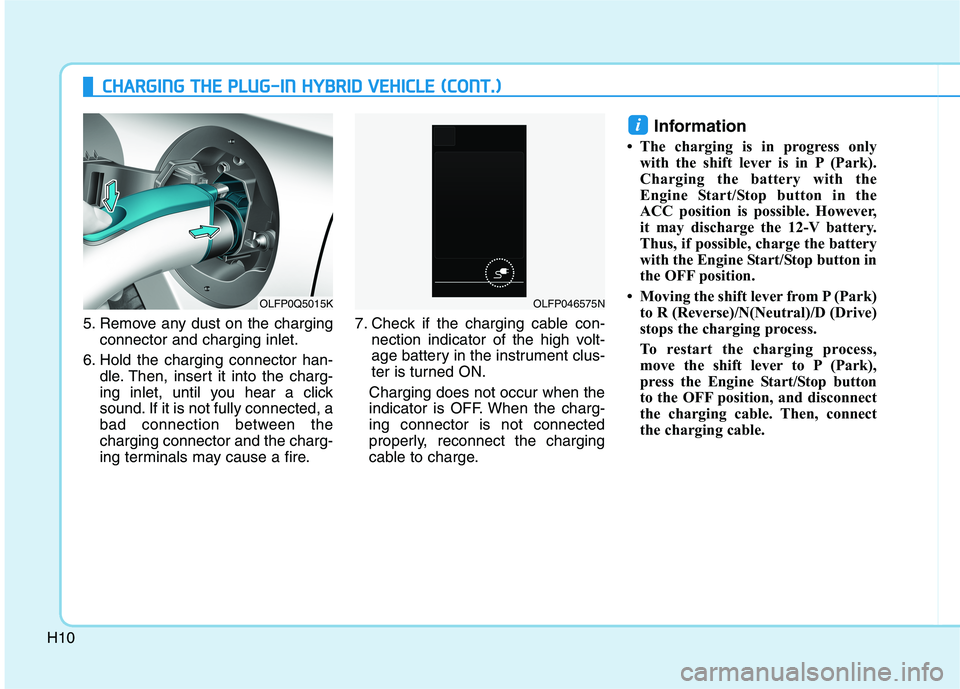
H10
CCHH AARRGG IINN GG TT HH EE PP LLUU GG--IINN HH YY BBRRIIDD VV EEHH IICC LLEE (( CC OO NNTT..))
5. Remove any dust on the charging
connector and charging inlet.
6. Hold the charging connector han- dle. Then, insert it into the charg-
ing inlet, until you hear a click
sound. If it is not fully connected, a
bad connection between thecharging connector and the charg-
ing terminals may cause a fire. 7. Check if the charging cable con-
nection indicator of the high volt-
age battery in the instrument clus-
ter is turned ON.
Charging does not occur when the
indicator is OFF. When the charg-ing connector is not connected
properly, reconnect the charging
cable to charge. Information
The charging is in progress only with the shift lever is in P (Park).
Charging the battery with the
Engine Start/Stop button in the
ACC position is possible. However,
it may discharge the 12-V battery.
Thus, if possible, charge the battery
with the Engine Start/Stop button in
the OFF position.
Moving the shift lever from P (Park) to R (Reverse)/N(Neutral)/D (Drive)
stops the charging process.
To restart the charging process,
move the shift lever to P (Park),
press the Engine Start/Stop button
to the OFF position, and disconnect
the charging cable. Then, connect
the charging cable.
i
OLFP0Q5015KOLFP046575N
Page 22 of 546
H11
8. After charging has started, theestimated charging time is dis-
played on the instrument cluster
for about 1 minute. It is also dis-
played, when the driver’s door is
opened with charging in progress.When scheduled charging is set,the estimated charging time is dis-
played as “--" .
Unlock Charging Door in
Emergency
If the charging door does not open
due to battery discharge, open thehood and slightly pull the emergency
cable as shown above. The chargingdoor will then open.
Charging Status
Checking Charging Status
You can monitor the charging status
outside of the vehicle when charging
the high-voltage battery.
OLFP075118
OLFP045260N
OLFPQ047737